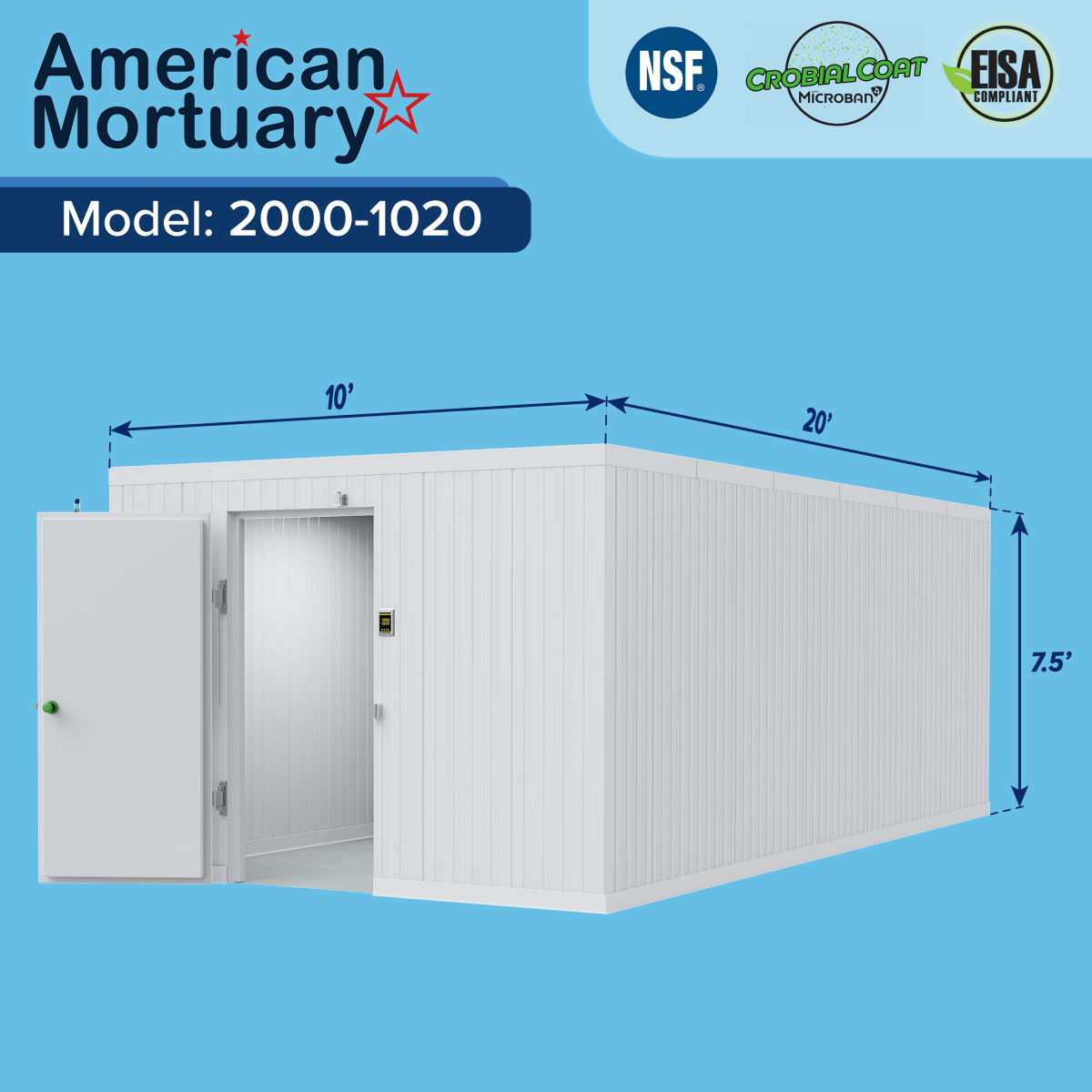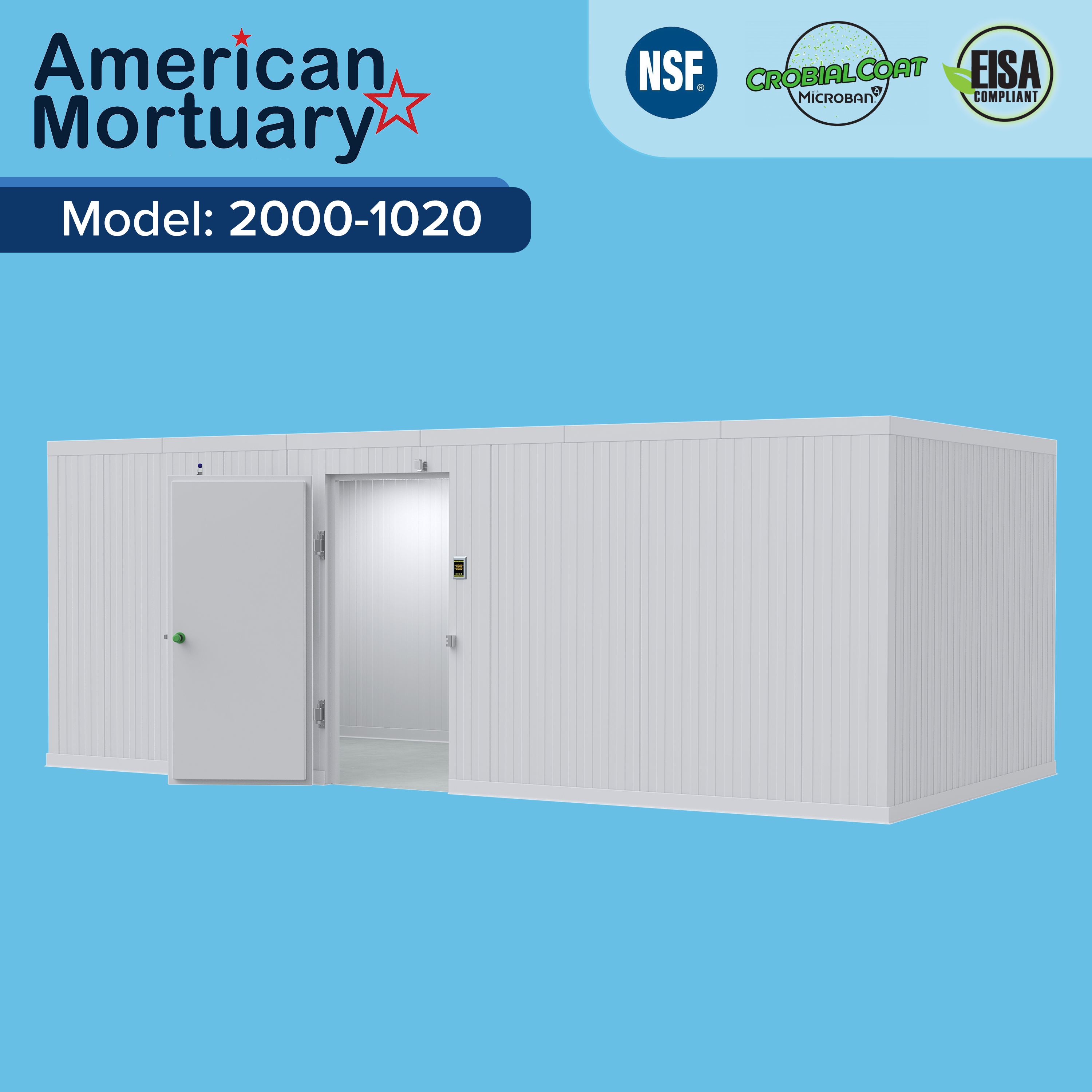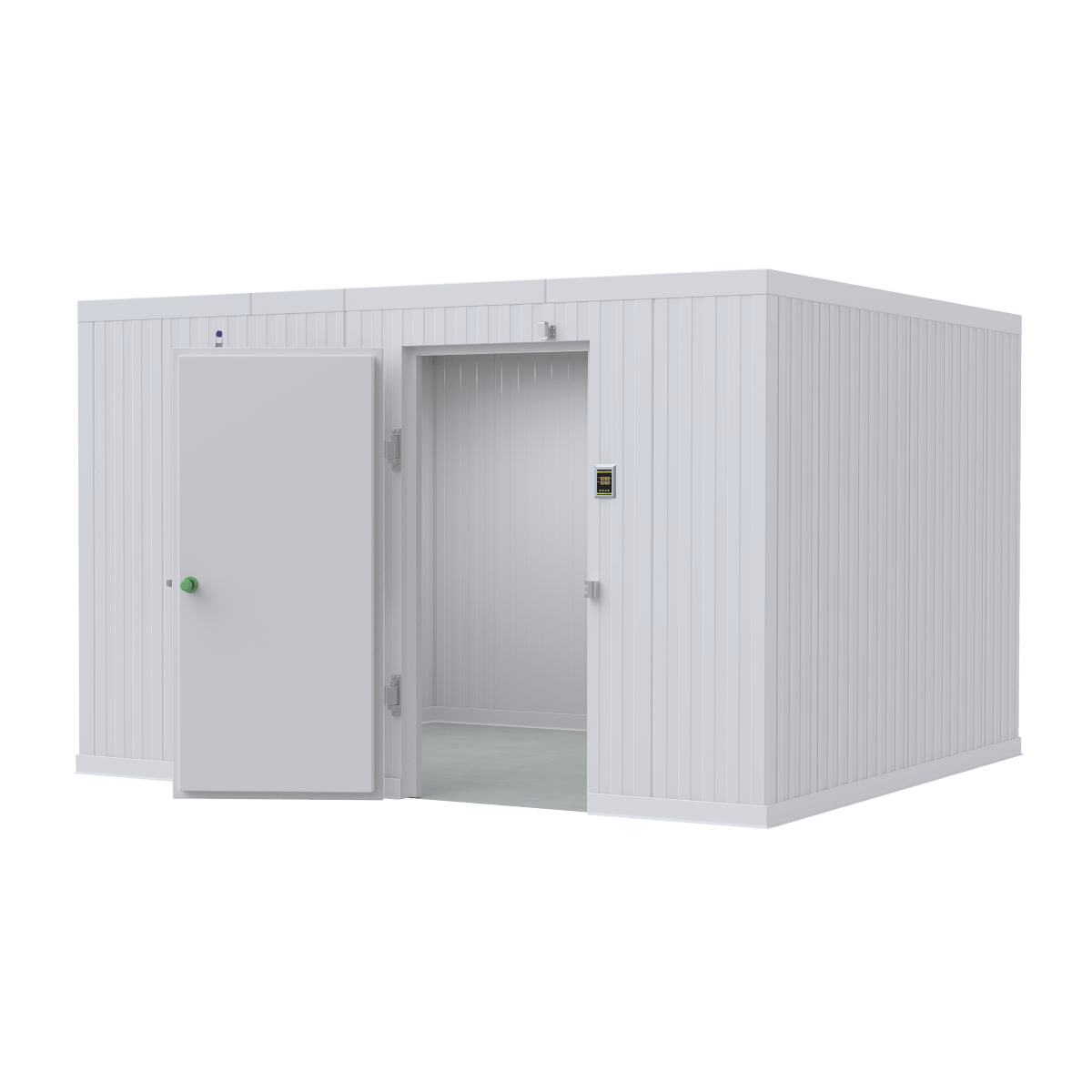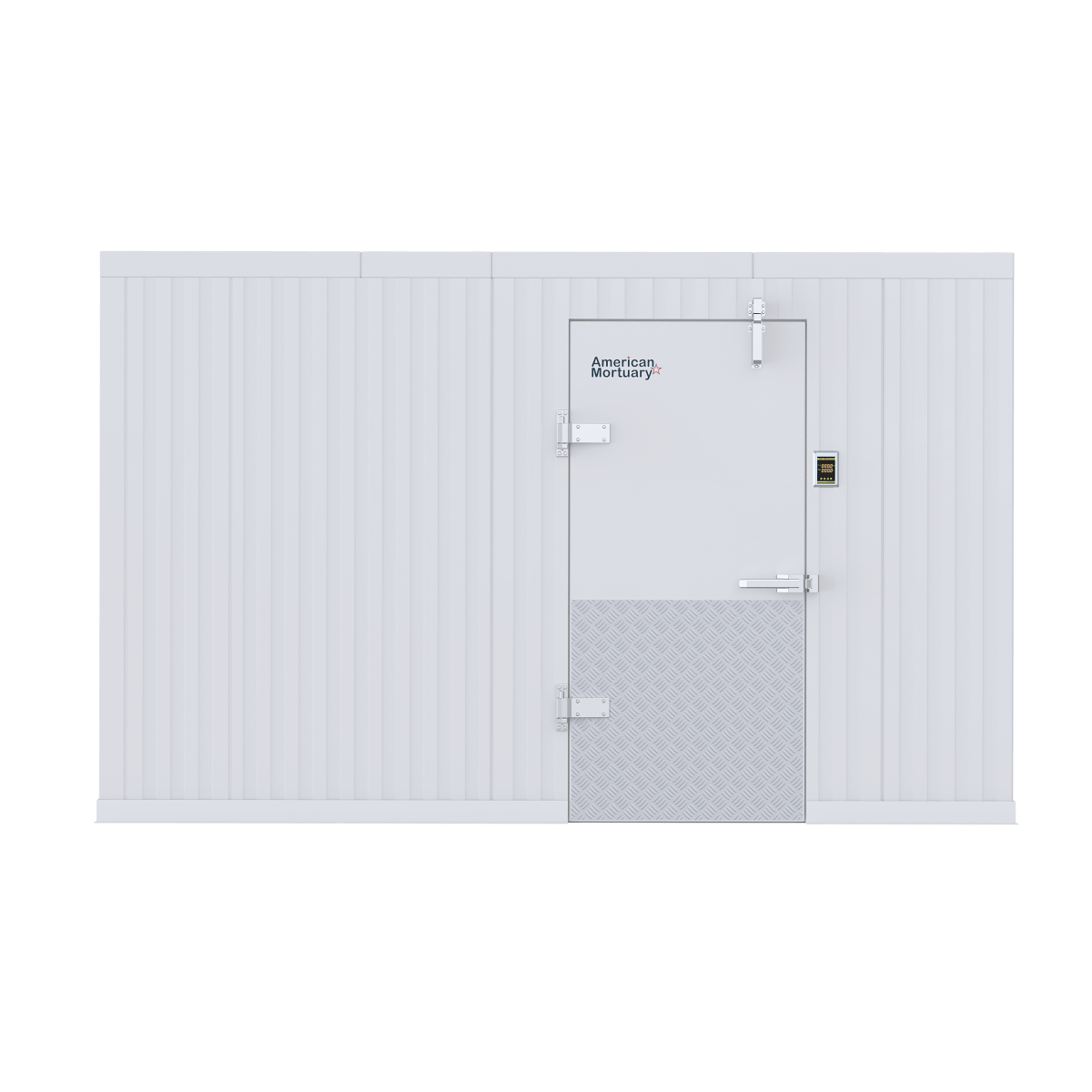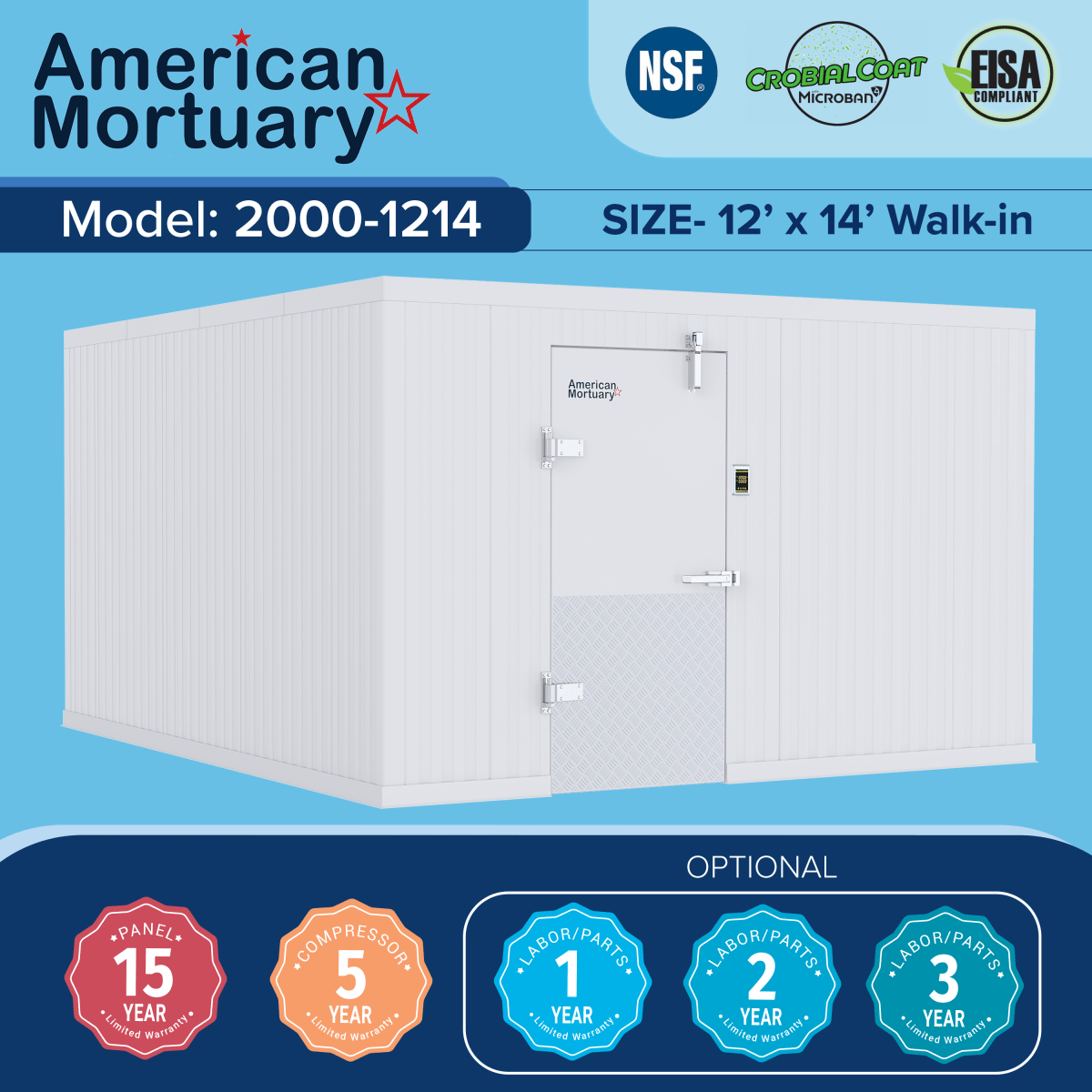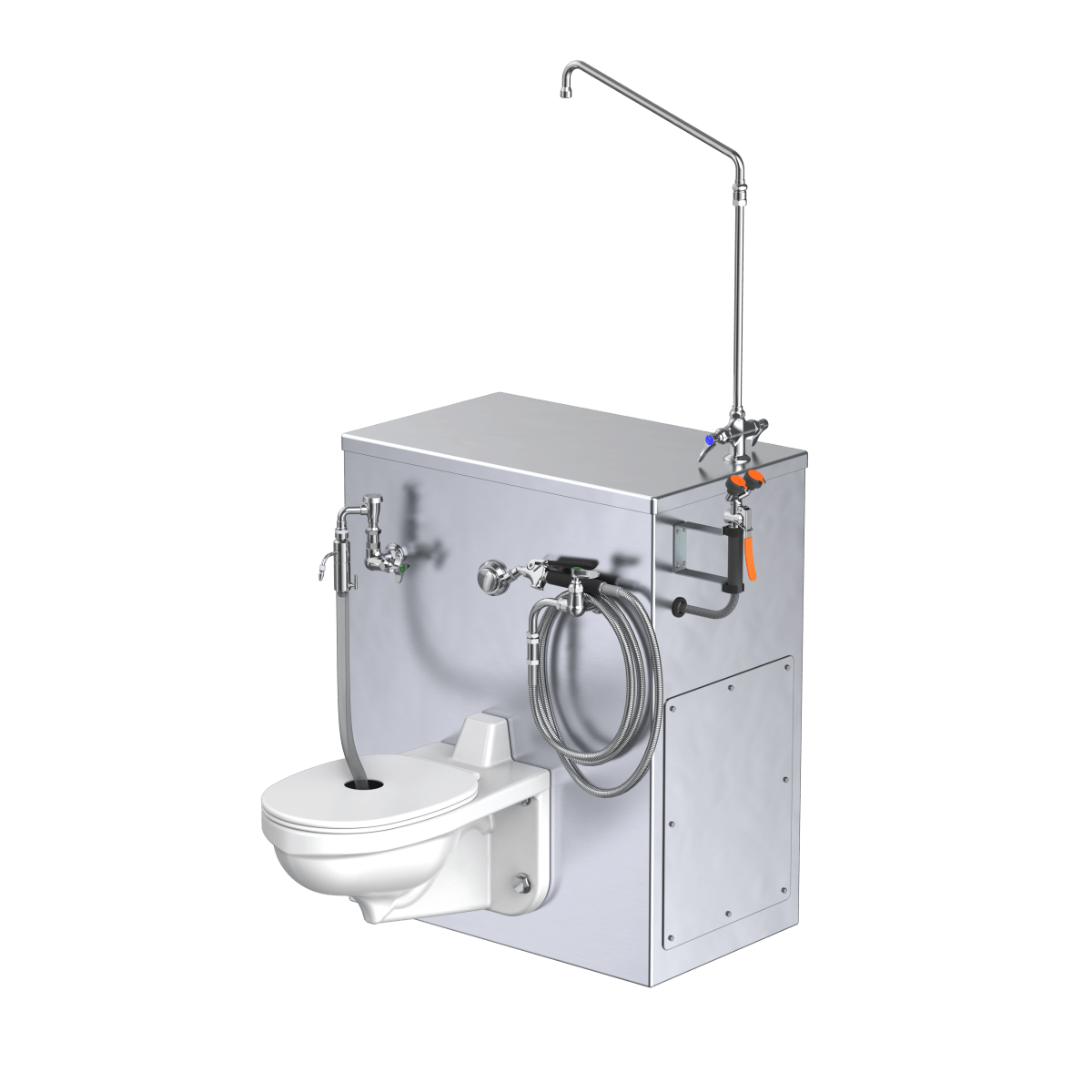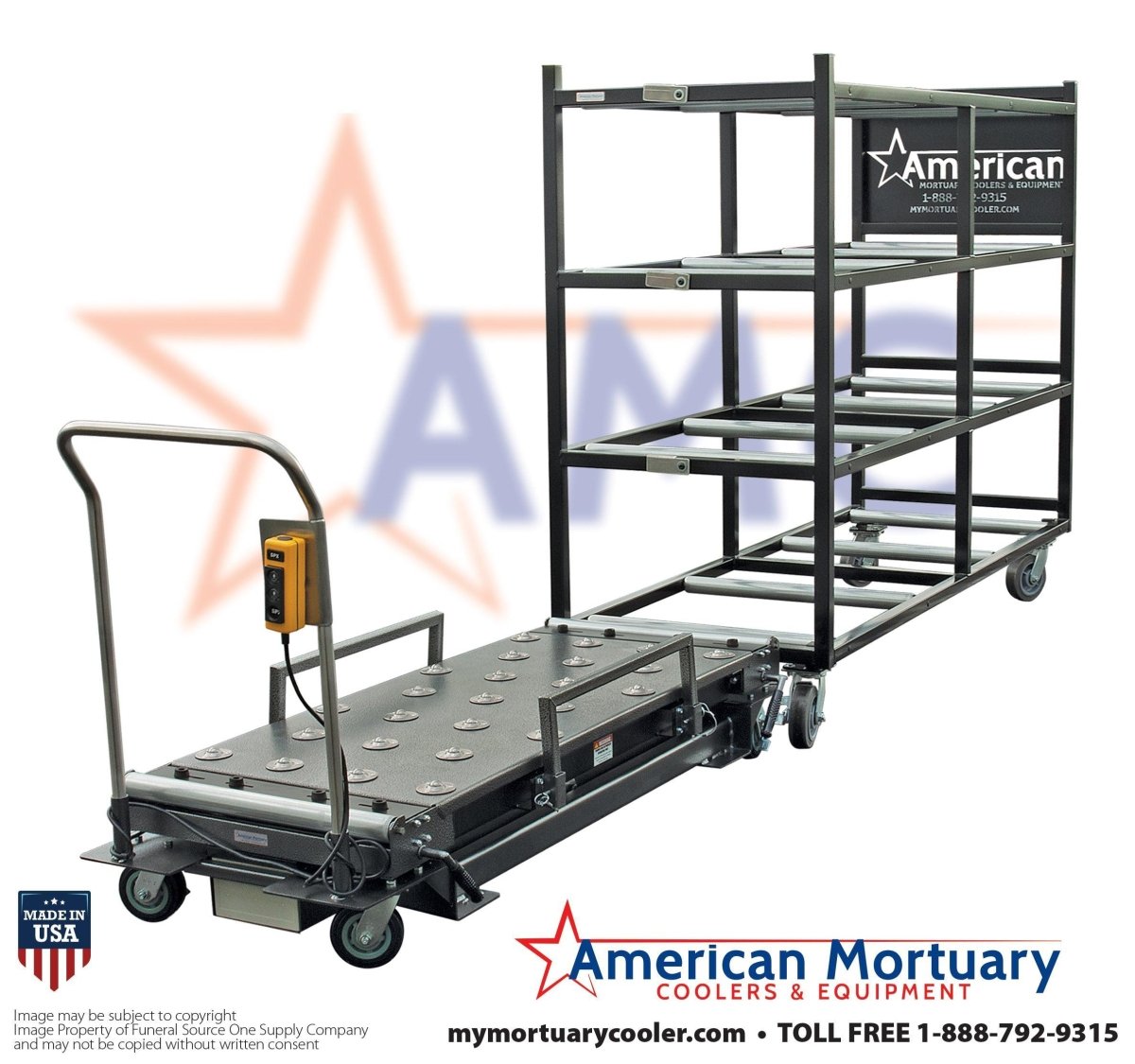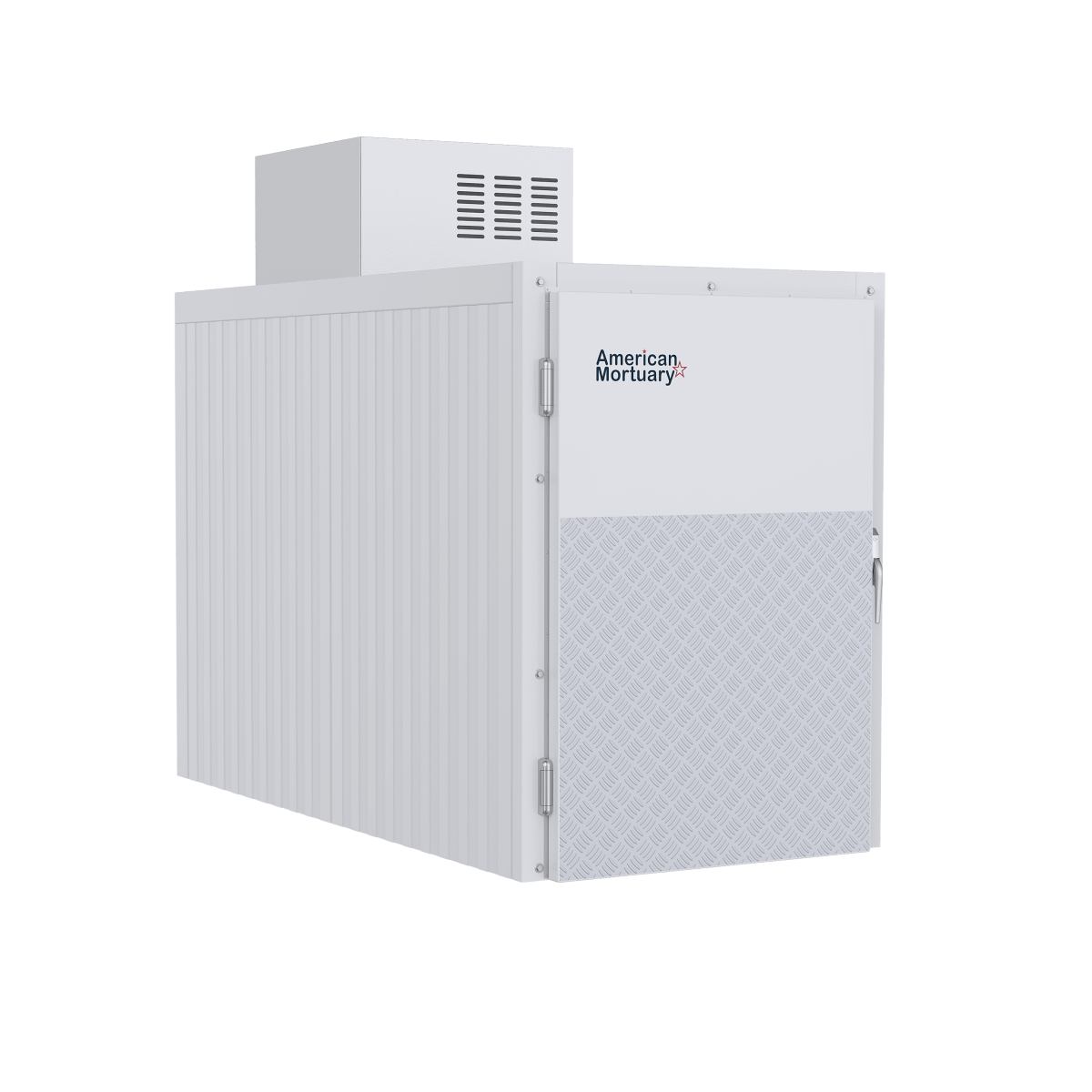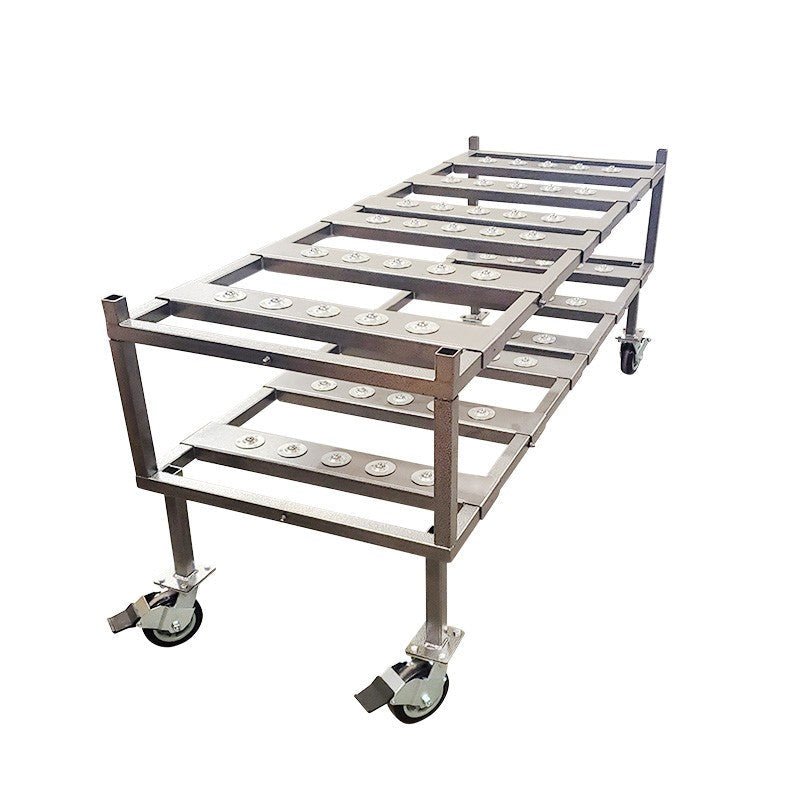Elevating Dignity: The Essential Role of Electric Mortuary Body Lifts
Electric mortuary body lifts are specialized lifting devices designed to safely transport deceased individuals within funeral homes, morgues, and medical facilities. They combine robust construction with precision engineering to support weights ranging from 180-1000 lbs.
| Top Electric Mortuary Body Lift Features | Benefits |
|---|---|
| Weight capacity (180-1000 lbs) | Handles everyday to bariatric cases |
| Battery operation (up to 150 cycles per charge) | Ensures reliable performance during power outages |
| Stainless steel construction | Enables thorough disinfection for hygiene |
| Low-profile design (13-13.5 inches) | Provides easier access in tight spaces |
| Single-person operation | Reduces staffing requirements |
| Safety features (automatic locks, brake wheels) | Prevents accidents and injuries |
In today's competitive funeral industry, efficiency and staff safety are paramount concerns. The right lifting equipment not only streamlines operations but significantly reduces the physical toll on your team.
"At the Mortuary Lift Company, we stand behind our casket lifts because we know they are the ultimate in prep-room lifting," notes one industry leader with over 50 years of experience.
For funeral directors, these lifts represent more than just equipment—they're essential tools that help maintain dignity in death care while protecting staff from the physical strain that once characterized the profession.
The growing demand for bariatric-capable equipment has pushed manufacturers to develop more robust systems, with some models now supporting over 900 pounds while maintaining maneuverability in tight spaces.
Many modern electric lifts also feature non-hydraulic designs, eliminating potential maintenance issues and environmental concerns associated with hydraulic fluid leaks.
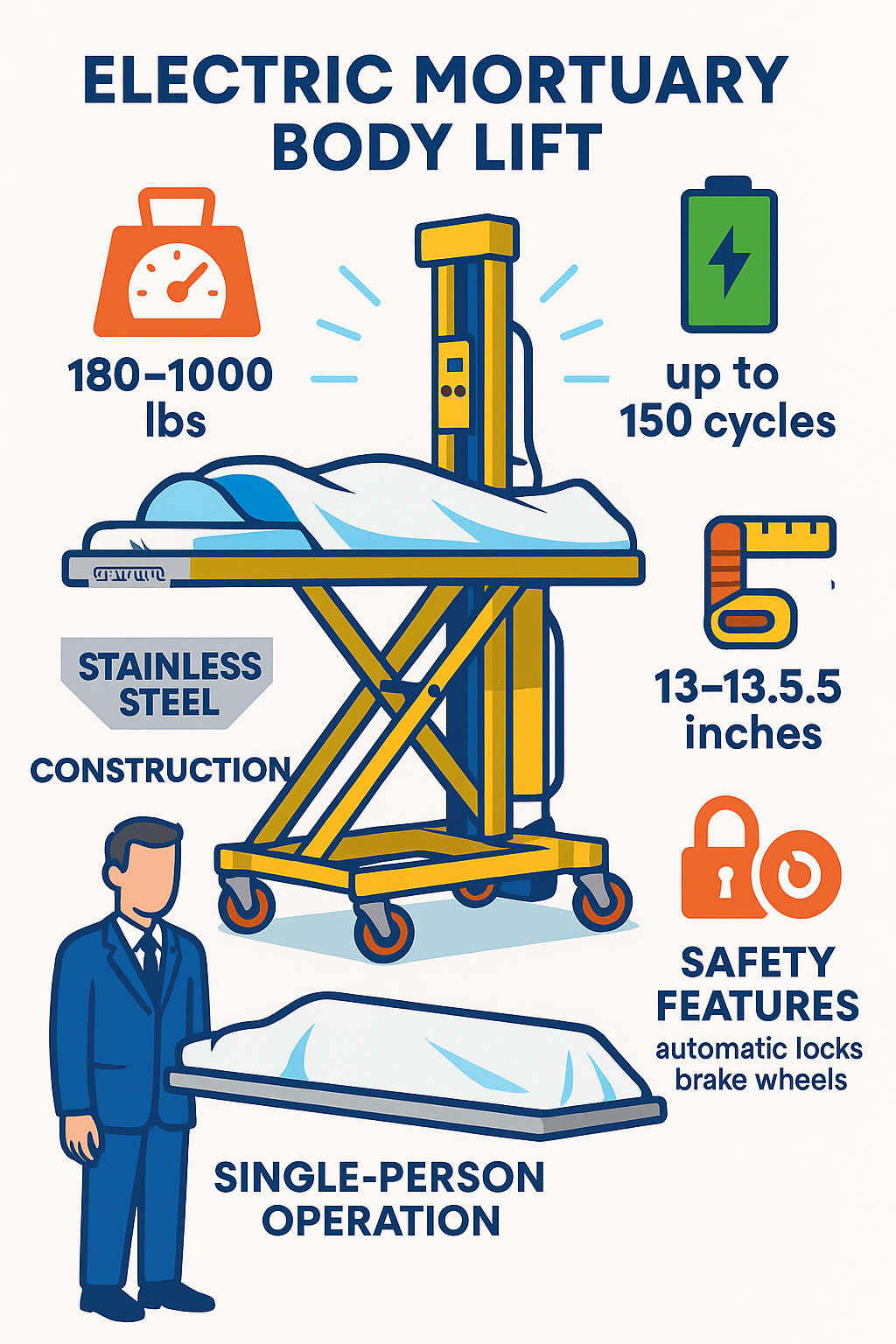
Simple guide to electric mortuary body lift terms:
Understanding Electric Mortuary Body Lifts
When you walk into a modern funeral home or morgue, you'll likely see one of the most essential pieces of equipment: the electric mortuary body lift. These aren't just machines – they're carefully designed tools that allow funeral professionals to handle one of their most important responsibilities with dignity and care.
Think of these lifts as specialized assistants, created with a single purpose in mind: to move deceased individuals safely and respectfully throughout a facility. Whether transferring from a preparation room to storage or from storage to a casket, these lifts make what was once a physically demanding task much more manageable.
The beauty of electric mortuary body lifts is in their thoughtful design. Unlike older manual systems that required significant physical effort, today's electric lifts use battery-powered motors to do the heavy lifting. With just the press of a button, the lift raises, lowers, and helps transport the deceased with smooth, controlled movements.

At American Mortuary Coolers, we've seen how these lifts transform daily operations in funeral homes across the country. From Maine to California, professionals tell us the same thing: once you switch to electric, there's no going back.
"When using the BodyHoist you treat a deceased with respect," as one manufacturer perfectly puts it. This isn't just marketing talk – it reflects the fundamental shift these devices bring to end-of-life care.
What makes a quality electric mortuary body lift? It starts with durable construction. Most premium models feature stainless steel 304-grade components or marine-grade aluminum that stands up to daily use and rigorous cleaning protocols. The lifting mechanism itself relies on a reliable electric actuator system powered by long-lasting rechargeable batteries.
The control systems are designed to be intuitive – typically featuring simple push-button operation right on the unit or, in more advanced models, convenient wireless remote controls. Mobility is ensured through high-quality casters with secure braking systems, allowing for easy movement when needed and rock-solid stability when positioned.
Weight capacity is a crucial consideration for any facility. Standard models typically handle between 200-400 pounds comfortably, while specialized bariatric models like the Electric Body & Casket Lift XL can support an impressive 900+ pounds. This range ensures there's an appropriate lift for every situation a funeral home might encounter.
Battery performance has become a standout feature in modern lifts. The best models, like the Electric Mortuary Scissor Lift, can perform up to 150 complete lifting cycles on a single charge. This exceptional battery life means reliability even during busy periods or power outages – a peace of mind that's invaluable in this profession.
We've noticed a clear trend across our service regions – from the Northeast to the Midwest to the Pacific states – as more facilities make the switch to electric systems. It's more than just keeping up with technology; it's about investing in tools that protect staff while honoring the deceased with the care they deserve.
Top Electric Mortuary Body Lift Features to Consider
Choosing the right electric mortuary body lift for your facility isn't just about getting a piece of equipment—it's about investing in a solution that will serve your team and the families you help for years to come. Let's walk through the features that truly matter when making this important decision.
Weight Capacity
When it comes to lift capacity, today's market offers solutions for every need. Standard models typically handle 200-375 pounds, which works well for many situations. However, we've seen a growing need for more robust options, with mid-range lifts supporting 400-650 pounds and heavy-duty models easily handling 800-900+ pounds.
The Electric Body & Casket Lift XL, for instance, confidently supports over 900 pounds—perfect for those challenging cases that have become increasingly common in our work. We always suggest choosing a lift with at least 20% more capacity than you think you'll need. This safety margin not only protects your staff but also future-proofs your investment as community needs change.
Adjustability and Range of Motion
Flexibility in movement makes all the difference in daily operations. A good electric mortuary body lift should offer height adjustments from a low profile (typically 13-13.5 inches at minimum) up to comfortable working heights (36-72 inches at maximum).
Multi-directional tops that allow both side and end loading have become particularly valuable features. The BodyHoist system, for example, offers adjustable shoulder width up to 600mm and ankle width settings of 350mm, allowing your team to provide proper support regardless of the deceased's physical dimensions. This kind of thoughtful design shows respect for each individual in your care while making your team's job easier.
Battery Performance
Nothing disrupts your workflow like equipment that won't power up when you need it. Today's advanced electric mortuary body lifts can operate up to 150 complete cycles on a single charge—that's 150 full raising and lowering operations before needing to plug in.

We've seen how valuable this reliability is during busy periods or power outages. Some systems, like the Electric Body & Casket Lift XL, offer dual power functionality, working on either battery power or standard wall outlets. This flexibility ensures you're never caught unprepared, even in challenging circumstances.
Safety Features
The safety of your team and the dignity of those in your care should never be compromised. Look for electric mortuary body lifts with automatic locking systems that prevent unexpected movement, emergency stop controls within easy reach, and overload protection systems that prevent operation when weight limits are exceeded.
Brake wheels for secure positioning are essential, especially when working in tight spaces. Some hybrid models also include choke valves and hydraulic safety systems for additional protection. These features aren't just about preventing accidents—they're about giving your team confidence as they perform their important work.
Material Quality
The materials used in your lift directly impact its durability, ease of cleaning, and overall lifespan. Stainless steel 304 construction offers superior corrosion resistance even with frequent disinfection, while marine-grade aluminum provides lightweight strength that makes maneuvering easier.
Non-porous surfaces aren't just about appearances—they enable the thorough disinfection required in our industry. Sealed electronic components protect against moisture damage, extending the life of your investment. When you consider that these lifts are used daily in challenging environments, these quality considerations become even more important.
Compatibility with Other Equipment
A lift that works seamlessly with your existing setup will save countless headaches. Consider how your new electric mortuary body lift will integrate with your mortuary coolers, transport vehicles, and preparation room layout. Will it work with your standard mortuary trays and body boards? These compatibility questions are often overlooked but can make a tremendous difference in day-to-day operations.
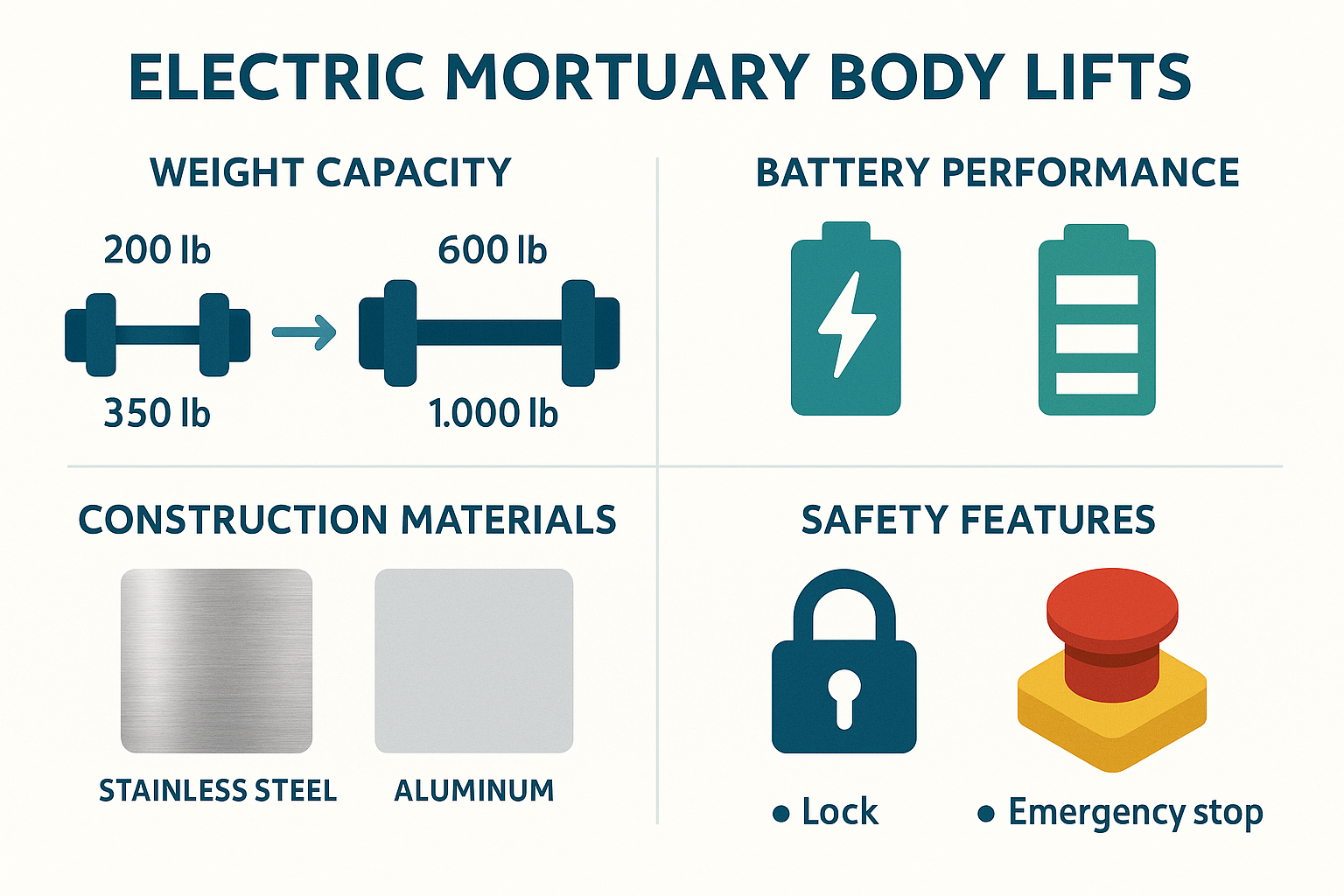
At American Mortuary Coolers, we've worked with facilities from small-town funeral homes in Johnson City to large metropolitan operations in Los Angeles. What we've learned is that the best lift for your facility depends on your unique patterns of operation. That's why we take the time to understand your specific needs before recommending solutions that will truly serve your team and the families who depend on you.
Our custom approach ensures you're not just getting equipment—you're getting a thoughtfully designed solution that respects both the living and the deceased in your care.
Benefits of Using Electric Mortuary Body Lifts
When we talk with funeral directors who've switched to electric mortuary body lifts, they often tell us it's one of the best investments they've ever made. These aren't just convenient tools—they're workplace transformers that bring real, everyday benefits to funeral professionals.
Think about what happens in a typical day at a funeral home. Staff members are constantly moving and transferring deceased individuals, often multiple times per case. Each of these movements traditionally required several people and put significant strain on everyone involved. Electric mortuary body lifts completely change this reality.
Reducing Physical Strain with Electric Mortuary Body Lifts
Let's face it—the physical demands of funeral work have always been challenging. Back injuries are unfortunately common in our industry, and they can be career-altering or even career-ending.
"I use mine all the time. Everyone should be using [electric lifts]," shared one female funeral director from the Finger Lakes region of New York. Another professional simply told us these systems have "saved my back," which really says it all.
The ergonomic design of modern electric mortuary body lifts protects your team by:
Eliminating manual lifting entirely, letting the machine handle the physical burden that once fell to your staff. The difference is immediately noticeable—especially at the end of a long day when fatigue typically sets in.
Preventing those dreaded back injuries that have plagued funeral professionals for generations. Many directors tell us they wish they'd made the switch years earlier.
Making bariatric cases manageable for everyone involved. With obesity rates rising across America, the ability to safely handle larger individuals without additional physical strain has become increasingly important for every funeral home.
Enhancing Operational Efficiency with Electric Mortuary Body Lifts
Beyond protecting your staff, these lifts create a ripple effect of efficiency throughout your entire operation.
One owner of two funeral homes in Ohio told us: "I am able to load cardboard cases for the crematory and load caskets to take to my other home by myself." This kind of independence represents significant operational advantages.
When one person can safely perform transfers that once required multiple staff members, you suddenly have much more flexibility. Your team can be deployed to other important tasks. You can handle removals after hours without calling in extra help. And your overall workflow becomes smoother and more predictable.
A coroner from Illinois was so impressed that he reported: "It's a great product, I've been calling surrounding counties telling them they should be using it." That kind of peer-to-peer recommendation speaks volumes.
We've seen funeral homes increase their case handling capacity by up to 30% without adding staff, simply because the electric mortuary body lift removes so many bottlenecks from their process. Transfers between preparation areas, coolers, and presentation spaces happen more quickly and with less coordination required.
When a funeral director from Rochester first saw one of our systems in action, they simply remarked: "You've thought of everything." That's exactly what we aim for—equipment that solves real problems that funeral professionals face every day.
Enhancing Safety
Safety improvements extend to both your team and the deceased individuals in your care:
Secure positioning is guaranteed through automatic locking mechanisms and brake systems that prevent unexpected movement. This is especially important when working in tight spaces or on uneven floors.
Controlled transfers happen with gentle precision, reducing the risk of accidents that can occur during manual handling. The slow, steady movement of an electric lift provides peace of mind during every transfer.
Reduced environmental hazards are another benefit, particularly with non-hydraulic designs that eliminate the risk of fluid leaks that could create slip hazards or contamination concerns in your preparation room.
Perhaps most importantly, these lifts support the core mission of funeral service: treating the deceased with dignity. As one manufacturer notes, "When using the BodyHoist you treat a deceased with respect." The smooth, controlled movement helps maintain positioning and prevents the undignified situations that can sometimes occur during manual transfers.
At American Mortuary Coolers, we've seen these benefits across funeral homes of all sizes—from small family operations in rural Tennessee to large urban facilities in Chicago. The consistent positive feedback we receive confirms what we already know: electric mortuary body lifts aren't luxury items—they're essential tools for the modern funeral professional who values staff wellbeing, operational efficiency, and dignified care.
Maintenance and Reliability of Electric Mortuary Body Lifts
Keeping your electric mortuary body lift in top working condition isn't just about protecting your investment—it's about ensuring you can provide consistent, dignified care for the families you serve. Like any sophisticated equipment that combines electrical, mechanical, and sometimes hydraulic components, these lifts need proper attention to deliver years of reliable service.
Regular Maintenance
The key to long-term reliability is establishing a consistent maintenance routine. Think of it as preventive healthcare for your equipment. A quick daily visual inspection takes just moments but can catch small issues before they become major problems. Look for anything unusual—loose parts, wear marks, or components that don't seem quite right.
Weekly, take a few minutes to run your lift through its full range of motion. Listen for unusual noises and watch for any hesitation in movement. This simple practice often reveals developing issues that aren't visible during static inspections.
Monthly checks should focus on the components that experience the most wear—casters, brakes, and locking mechanisms. These parts bear significant stress during daily operations and tend to show problems first.
"Most equipment failures we see could have been prevented with basic maintenance," notes one of our technicians who services facilities from Memphis to Charlotte. "The lifts that last longest are the ones that get regular attention."
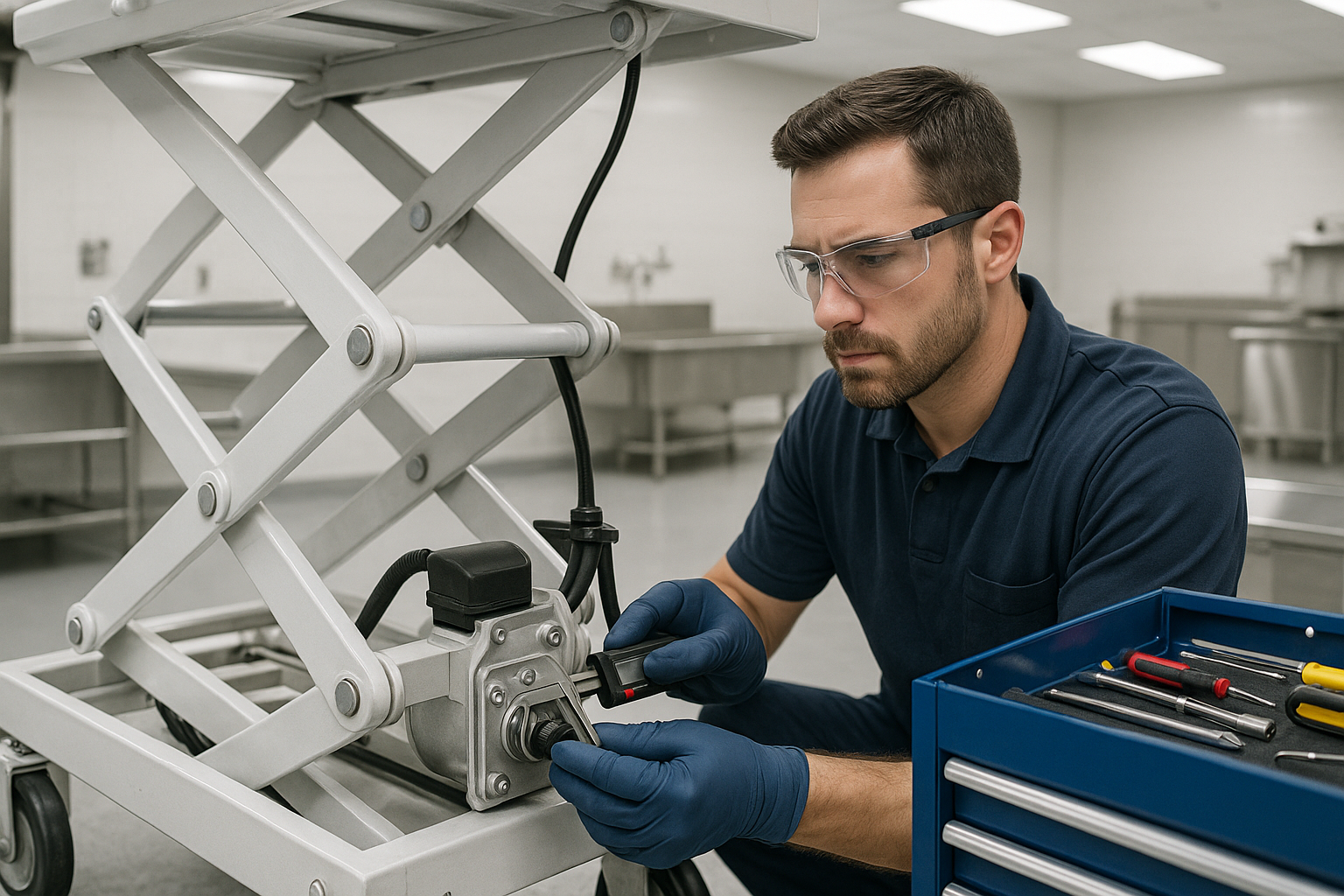
Cleaning and Disinfection
In the funeral industry, cleanliness isn't just about appearances—it's a matter of health and safety. Your electric mortuary body lift needs thorough cleaning after each use, focusing especially on surfaces that contacted the deceased.
Many of our customers have developed efficient cleaning routines that protect both their equipment and their staff. For example, a funeral director in Nashville shared that they keep appropriate disinfectant wipes next to their lift station, making it easy for staff to clean immediately after transfers.
The stainless steel 304 construction found in quality lifts makes this process much easier. This non-porous material resists bacterial growth and stands up to regular disinfection without degrading. Some advanced models even include built-in water outlets specifically designed to make tray cleaning more convenient.
Battery Care
The battery system is literally the power behind your electric mortuary body lift, and proper care ensures it's ready when you need it. Most manufacturers recommend specific charging practices—some batteries perform best when fully discharged before recharging, while others maintain better longevity when topped up regularly.
"I learned the hard way about battery maintenance," a funeral director from Louisville told us. "Now I have a simple calendar reminder to check battery status weekly, and I haven't had an unexpected failure since."
Most lift batteries need replacement every 2-3 years, though this varies based on usage patterns and care. Keeping track of performance changes helps you anticipate when replacement might be needed, avoiding unexpected downtime during critical operations.
Mechanical Component Care
The moving parts of your lift require specific attention to continue functioning smoothly. Proper lubrication, applied according to manufacturer specifications, prevents unnecessary wear and ensures quiet, smooth operation—something particularly important when transfers occur in spaces visible to families.
Hardware naturally loosens over time with regular use. A quick check with appropriate tools to ensure bolts and fasteners remain tight can prevent component failures and extend equipment life. Pay special attention to casters and their braking mechanisms, as these components bear significant stress during daily use.
Electronic System Maintenance
Today's advanced electric mortuary body lifts include sophisticated electronic controls that benefit from specific care. Verify regularly that all buttons, switches, and remote controls function properly. Check that wiring connections remain secure and undamaged, especially in areas where cables might flex during operation.
Some of the newest models include digital weight scales and positioning systems that may require occasional recalibration to maintain accuracy. If your lift includes software-controlled components, check periodically with the manufacturer for available updates that might improve performance or add features.
Best Practices for Long-Term Reliability
Our experience working with funeral homes across the country has shown that proper training makes an enormous difference in equipment longevity. When all staff members understand correct operation, they're less likely to inadvertently cause damage through misuse.
Maintaining detailed maintenance logs might seem like unnecessary paperwork, but these records often reveal patterns that help anticipate needs before they become urgent. A funeral director in Louisville showed us a simple log that helped them identify a recurring issue with one component, leading to a permanent fix rather than repeated temporary repairs.
Keeping essential spare parts on hand makes sense for components that commonly need replacement. While you probably don't need an extensive inventory, having items like specific fuses, common fasteners, or specialized batteries can prevent extended downtime when something needs attention.
At American Mortuary Coolers, we've found that the facilities reporting the fewest problems with their equipment tend to be those that develop relationships with qualified service technicians before emergencies occur. Knowing who to call when something needs professional attention—and having that relationship already established—can turn a potential crisis into a minor inconvenience.
By approaching maintenance thoughtfully and consistently, your electric mortuary body lift will provide years of reliable service, allowing you to focus on what matters most: the families who depend on your care during difficult times.
Integration with Other Mortuary Equipment
The magic of an electric mortuary body lift isn't just in what it can do alone—it's how it works with your other equipment to create a seamless workflow. Think of it as the connecting piece in a puzzle that brings everything together in your facility.
Compatibility with Coolers
Let's face it—moving bodies in and out of coolers is one of the most frequent tasks in any funeral home or morgue. When your lift and cooler work well together, what was once a challenging task becomes almost effortless.
Good compatibility means your lift can slide right up to the cooler with the right height alignment. Those low-profile designs (usually 13-13.5 inches at their lowest) are no accident—they're specifically engineered to glide under cooler units without a hitch. Quality casters make that transition over thresholds smooth rather than jarring.
At American Mortuary Coolers, we think about this relationship from the beginning. When we design a custom cooler for your facility, we consider the specific dimensions of your lift system so they work together like dance partners who've been practicing for years.
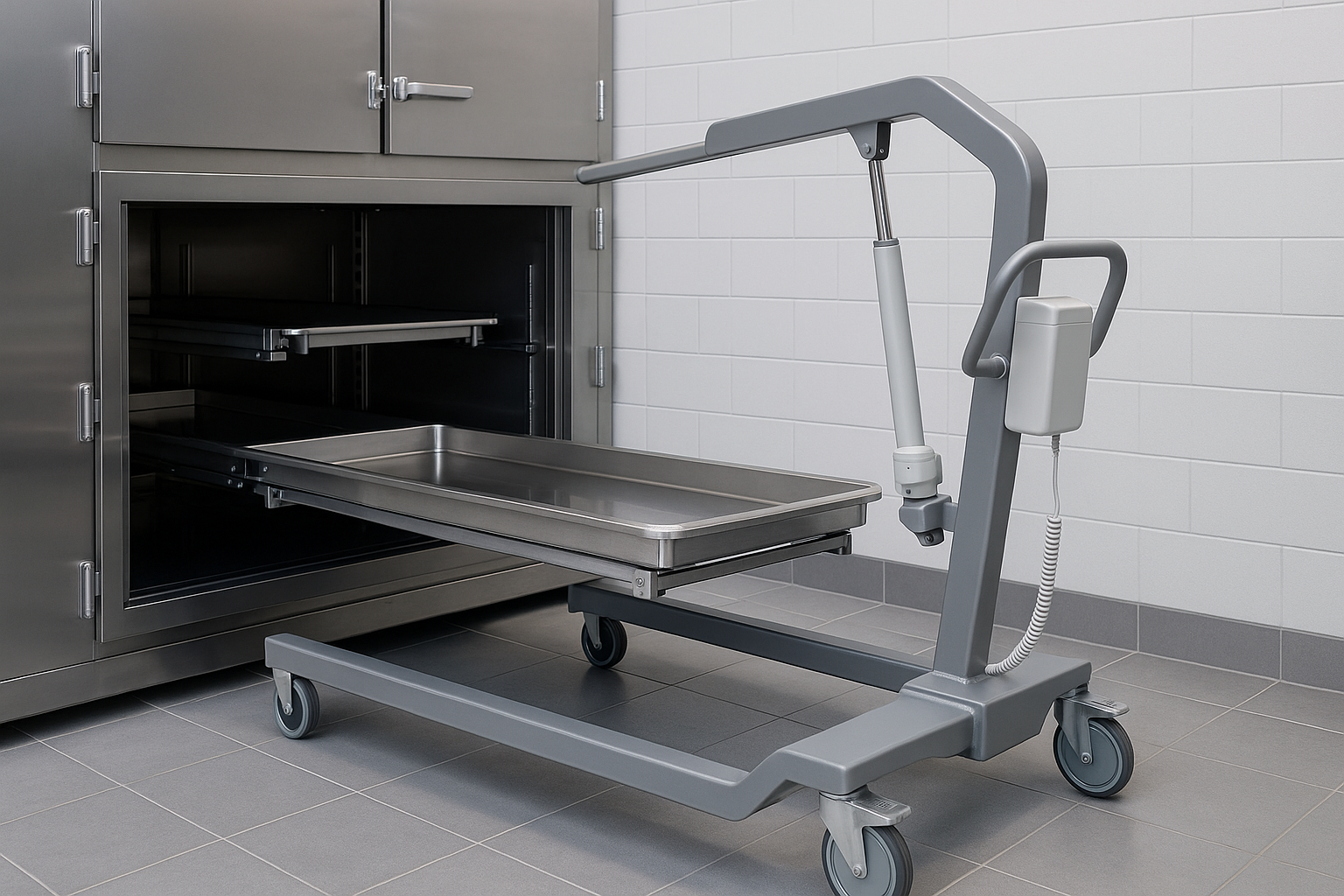
Integration with Transport Systems
Moving between rooms is one thing, but what about between facilities? That's where transport integration becomes crucial.
Some systems, like the Tug-Along Casket & Gurney Winch, are specifically designed to make vehicle loading and unloading less of a headache. Good lifts can handle ramps and inclines without wobbling or feeling unstable. Transfer boards create a smooth bridge between your lift and other transport equipment.
One funeral director told us he became "completely dependent on the device to load mortuary cargo" after just a few uses. That's not surprising—once you experience how much easier these integrated systems make your job, it's hard to imagine going back to the old way of doing things.
Maximizing Operational Efficiency
When everything works together, the benefits multiply. You create what we like to call a "continuous workflow" where there are no stopping points or bottlenecks. You're handling the deceased fewer times, which is better for both dignity and efficiency.
Well-integrated equipment also makes better use of your available space. Instead of needing wide clearances and staging areas, complementary equipment footprints let you maximize every square foot of your facility. And perhaps best of all, you'll often need fewer staff members to complete the same tasks when your equipment works together harmoniously.
Integration with Preparation Room Equipment
The preparation room presents its own unique integration challenges. Your electric mortuary body lift needs to align perfectly with embalming tables—even a small height discrepancy can make transfers awkward.
Maneuverability becomes especially important in prep rooms where space is often at a premium. Your lift should be able to steer around fixed equipment without becoming a bumper car. And since fluid exposure is always a possibility during transfers in this area, good integration includes systems designed to handle these conditions without damage.
Even electrical systems need coordination—knowing where outlets are located and ensuring power requirements don't conflict with other equipment is part of thoughtful integration.
Custom Integration Solutions
At American Mortuary Coolers, we know that no two facilities are exactly alike. That's why we take a personalized approach to integration across all our service regions—from Columbia to Dallas and everywhere in between.
We start with a thorough facility assessment to understand what you're working with. Then we analyze your workflow to identify where transfers happen and where bottlenecks might be occurring. This allows us to develop custom specifications that ensure all your systems talk to each other effectively.
During installation, we provide hands-on guidance to verify everything is working together as planned. And our support doesn't end when we drive away—we offer continuing assistance to help you refine your integration as your needs evolve.
The LoadAlone™ system is a perfect example of effective integration in action. It transforms everyday vehicles into specialized mortuary transport systems through thoughtful design that considers the entire transfer process from beginning to end.
By thinking about your mortuary equipment as a connected system rather than standalone pieces, you'll find significant improvements in efficiency and safety. Your staff will thank you for the reduced physical strain, and you'll maintain the highest standards of dignity for the deceased throughout every transition.
Electric vs. Manual or Hydraulic Mortuary Body Lifts
When it comes to choosing the right lifting equipment for your funeral home or mortuary, understanding the differences between electric, manual, and hydraulic options can significantly impact your daily operations. Each technology brings its own set of advantages and considerations that affect everything from staff wellbeing to your bottom line.
Performance Comparison
Electric mortuary body lifts have revolutionized how we move and transfer the deceased. With smooth, consistent movement at about 1-2 inches per second, they offer precision that manual systems simply can't match. The push-button operation requires virtually no physical effort, which is a game-changer for staff who previously relied on their own strength to manage transfers.
Most electric models support between 200-1000+ pounds, with their rechargeable batteries typically lasting through an impressive 150 cycles before needing a charge. This means you can often operate for several days of normal use without worrying about power.
Manual lifts, while less expensive, tell a different story. Their lifting speed varies dramatically based on who's operating them, and precision depends entirely on operator skill. The physical exertion required through cranking or pumping mechanisms can be substantial, especially at the end of a long day. Weight capacity typically tops out around 300-500 pounds, which can be limiting for bariatric cases.
Hydraulic systems fall somewhere in between. They offer relatively quick, smooth operation with good positional control, but still require moderate physical effort to pump the hydraulic systems. Their typical capacity ranges from 500-800 pounds, making them more versatile than manual options but potentially less capable than high-end electric models.
Cost Considerations
Let's be honest – budget matters. The financial picture extends well beyond the price tag you see when making your purchase.
Electric lifts typically represent the highest initial investment, with premium models like the Electric Body & Casket Lift XL priced around $3,595 (reduced from $4,495). Manual systems are the most budget-friendly upfront, usually ranging from $1,200-$2,500, while hydraulic options typically fall between $2,500-$4,500.
However, the true financial story unfolds over time. Electric systems require battery replacement every 2-3 years and minimal electricity costs. Manual systems have virtually no ongoing operational expenses, while hydraulic systems need fluid replacement and seal maintenance periodically.
Perhaps the most significant financial factor is staffing efficiency. Electric systems often allow single-person operation, while manual systems typically need 2-3 staff members for safe operation. When you calculate the labor savings over even a single year, the higher initial cost of an electric system often pays for itself remarkably quickly.
"I can now handle removals by myself when necessary, which has completely changed our after-hours response capability," shared one funeral director from Michigan. This kind of operational flexibility translates directly to cost savings and improved service.
Advantages of Electric Lifts
The growing preference for electric mortuary body lifts across the industry isn't just a trend – it's based on tangible benefits that improve daily operations.
Staff safety stands at the forefront of these advantages. Electric systems virtually eliminate the physical strain associated with manual lifting, significantly reducing workplace injuries. As one grateful user put it, these systems have "saved my back," a sentiment we hear repeatedly from funeral professionals who've made the switch.
The operational efficiency gains are equally impressive. The ability for a single person to manage transfers independently creates substantial workflow improvements throughout the facility. One owner reported being able to "load caskets to take to my other home by myself," highlighting the newfound independence these systems provide.
Electric lifts deliver consistent performance regardless of operator strength or fatigue level. This means the same smooth, controlled transfer experience at 8 am or 8 pm, during your busiest week or your quietest. This consistency extends to bariatric capabilities as well, with advanced electric models safely handling weights exceeding 900 pounds – an increasingly important consideration in today's funeral service environment.
Perhaps most importantly, electric systems contribute to more dignified handling of the deceased. As one manufacturer noted, "When using the BodyHoist you treat a deceased with respect." The smooth, controlled movement minimizes unnecessary jostling or awkward transitions that can occur with manual systems.
Environmental Impact
Modern electric mortuary body lifts often feature non-hydraulic designs, eliminating concerns about fluid leaks that could create slip hazards, contamination risks, or environmental disposal issues. This hydraulic fluid-free approach means no more worrying about stains on your preparation room floor or potential contamination in sensitive areas.
While battery disposal presents its own environmental considerations, today's systems increasingly use environmentally friendly battery technologies with established recycling protocols. Many manufacturers now offer battery recycling programs that make responsible disposal simple and straightforward.
| Feature | Electric Lifts | Manual Lifts | Hydraulic Lifts |
|---|---|---|---|
| Initial Cost | $3,500-$6,500 | $1,200-$2,500 | $2,500-$4,500 |
| Physical Effort | Minimal | Substantial | Moderate |
| Maintenance | Battery care, electronic systems | Simple mechanical maintenance | Hydraulic fluid, seals, mechanical parts |
| Environmental Concerns | Battery disposal | None | Potential fluid leaks |
| Single-Person Operation | Yes | Limited by weight | Partially |
| Power Outage Function | Battery backup | Fully functional | Manual backup on some models |
| Lifespan | 7-10+ years | 10-15+ years | 8-12+ years |
At American Mortuary Coolers, we've observed a clear trend across our service regions—from Pittsburgh to Los Angeles—toward electric systems, particularly in facilities handling higher case volumes or those with limited staffing. Funeral directors increasingly view the initial investment as worthwhile, paying dividends through improved operational efficiency and staff wellbeing.
When you consider the complete picture – from performance capabilities to long-term costs to staff health – electric mortuary body lifts offer compelling advantages that explain their growing popularity in modern funeral service.
Latest Technological Advancements in Electric Mortuary Body Lifts
The world of electric mortuary body lifts has seen remarkable innovation in recent years. What was once basic lifting equipment has evolved into sophisticated systems that bring new levels of safety, efficiency, and dignity to mortuary operations. These advancements aren't just technical improvements—they represent a fundamental shift in how funeral professionals can care for the deceased while protecting their own wellbeing.
Battery Technology Improvements
Remember the days of constantly worrying about your lift's battery life? Those concerns are quickly becoming a thing of the past.
Today's electric mortuary body lifts feature lithium-ion batteries that deliver impressive performance even during the busiest days. Modern systems can support up to 150 complete lifting cycles on a single charge—enough to handle multiple days of operations in many facilities.
"The battery reliability has completely changed how we schedule our work," shared one funeral director from Nashville. "We used to plan transfers around battery status, but now we just work naturally without that concern."
Many newer models also feature quick-charge capability, reaching 80% capacity in just 1-2 hours. This rapid recharging means even busy facilities rarely experience downtime. The Electric Body & Casket Lift XL takes this flexibility even further with dual power systems that can operate on either battery power or direct electrical connection, ensuring you're never caught without power when you need it most.
Smart battery management systems have also become standard in premium models, optimizing charging patterns and preventing the overcharging that once shortened battery life. These intelligent systems extend the useful life of batteries while reducing replacement frequency and costs.
Safety Certifications and Standards
Safety standards for electric mortuary body lifts have become significantly more rigorous, giving funeral professionals greater confidence in their equipment.
Leading manufacturers now design their systems to ISO 13485:2016 standards, originally developed for medical devices. Many also follow NEN-EN-ISO 10535:2007 guidelines that were created for patient lifting equipment but adapt perfectly to mortuary applications. These standards ensure consistent quality and safety across production runs.
"The certification differences between our new lift and our old one are night and day," explained a funeral home owner from Missouri. "You can literally see and feel the difference in build quality and safety features."
Some advanced systems incorporate materials that meet European ADR safety standards for handling biological materials, while components that contact the deceased often meet NSF standards for cleanability and non-porosity. These certifications aren't just paperwork—they represent real-world safety improvements that protect both staff and the deceased.
Innovative Materials
The materials used in modern electric mortuary body lifts have evolved dramatically, creating equipment that's simultaneously lighter, stronger, and easier to maintain.

Marine-grade aluminum has become increasingly common, offering remarkable strength while significantly reducing the overall weight of the equipment. This lighter construction makes the lifts easier to maneuver in tight spaces—a crucial advantage in smaller preparation rooms.
High-quality 304 stainless steel components resist corrosion even with frequent exposure to the harsh cleaning chemicals necessary in mortuary environments. This durability translates directly into longer equipment life and lower lifetime ownership costs.
Modern lifts also feature specialized cover coating systems that facilitate thorough disinfection while maintaining an attractive appearance. These non-porous surfaces prevent bacterial harboring, addressing a key concern in facilities handling multiple cases daily.
Traditional steel cables have largely been replaced with synthetic alternatives that offer improved durability and reduced maintenance requirements. These cables maintain their integrity even after thousands of lifting cycles, improving both safety and reliability.
Advanced Features
The functionality of today's electric mortuary body lifts extends far beyond simple raising and lowering, with features that would have seemed futuristic just a decade ago.
Digital Weight Scales
Integrated weighing systems have become increasingly common, eliminating the need for separate equipment and extra handling steps. These systems typically feature clear LCD displays that provide immediate, easy-to-read weight information.
"The built-in scale has been a game-changer for our record-keeping," noted a funeral director from Kentucky. "We get accurate weights without any additional handling, which feels more respectful to the deceased."
Some advanced systems can even log weights automatically for record-keeping, while self-calibrating mechanisms maintain accuracy over time without requiring manual adjustments. As one manufacturer describes it, their "new design table weighing function" uses "a weight sensor installed under the table" to provide real-time data directly on the control panel.
Remote Control Operation
Wireless control systems have transformed how funeral professionals interact with lifting equipment. Handheld remotes allow operation from optimal viewing positions, improving safety during positioning and transfers.
Many systems now offer multiple control points—both onboard controls for direct operation and remote options for situations where distance provides better visibility. Sophisticated safety lockouts prevent unauthorized or accidental activation, addressing a key concern in facilities where family members might be present.
Multi-Directional Movement
The days of awkward repositioning and multiple transfers are fading thanks to advanced mobility features. Bi-directional tops allow bodies to be moved in multiple directions without repositioning the entire lift, while rotational capabilities help align with receiving surfaces like embalming tables or cooler trays.
Adjustable width settings accommodate different body sizes, making these systems truly versatile across all cases. One funeral director from Illinois shared, "The adjustable settings mean we provide the same dignified handling regardless of the deceased's size—it's about treating everyone with equal respect."
Specialized Lifting Mechanisms
Perhaps the most impressive innovations involve the core lifting function itself. Electric stair climbing systems like The Stepper can steer stairs electrically, eliminating one of the most physically demanding and potentially dangerous aspects of body transport.
Scissor lift designs provide exceptional stability and precise height control, while newer motors operate with significantly reduced noise for more respectful handling. "The quieter operation makes a real difference during transfers when family is present," explained a funeral director from Georgia. "It maintains the dignity of the moment."
At American Mortuary Coolers, we closely follow these technological developments to ensure our customers across the country—from the Rocky Mountains to the Southeast—have access to the most advanced lifting solutions that match their specific needs. Our custom approach allows us to incorporate these innovations while maintaining our focus on what matters most: practical, reliable equipment that helps you provide dignified care day after day.
Frequently Asked Questions about Electric Mortuary Body Lifts
What weight capacities are commonly available, and what do they mean for my facility?
When shopping for an electric mortuary body lift, you'll notice they come in various weight capacities to match different needs. Think of it like choosing the right truck for your hauling needs – you want enough capacity without going overboard.
Standard models typically handle 200-375 pounds, which works well for facilities dealing mostly with average-sized individuals. If you occasionally work with larger individuals, you might prefer models in the 400-650 pound range. For facilities regularly handling bariatric cases, heavy-duty options supporting 800-900+ pounds make more sense. Some specialized bariatric lifts can even accommodate 1000+ pounds for facilities focusing on these cases.
Here at American Mortuary Coolers, we've helped funeral homes across the country find their perfect fit. We typically suggest looking at your case history from the past few years to spot any weight trends. It's also smart to think ahead – the average weight of the deceased continues to increase in many regions.
"Always build in a safety cushion," as one of our specialists likes to say. We recommend selecting a capacity at least 20% above your typical maximum needs. Just remember that higher capacity units might be a bit larger or heavier, so there's a balance between capacity and maneuverability.
For our customers in the Midwest and Southeast where obesity rates tend to be higher, we usually recommend systems with at least 650-pound capacity. This ensures you're covered for most situations without having to turn families away.
How often does an electric mortuary body lift need maintenance?
Just like your car needs regular check-ups, your electric mortuary body lift thrives with consistent care. Good maintenance isn't just about preventing breakdowns – it's about ensuring dignity in your services and safety for your staff.
Daily care is pretty straightforward – a quick visual inspection for any obvious damage, checking that the battery is charged, and cleaning any surfaces that contacted the deceased. This takes just a minute or two but can prevent bigger issues down the road.
Weekly, you'll want to run the lift through its complete range of motion to make sure everything's working smoothly. Take a closer look at the casters and braking systems, and give all surfaces a thorough cleaning. One funeral director told us this weekly ritual "helps me spot little issues before they become big problems."
Monthly maintenance digs a little deeper – inspect all moving parts, verify all safety mechanisms are functioning properly, and test how well the battery is performing. These monthly check-ups typically take about 15-20 minutes but save hours of potential downtime later.
Quarterly, we recommend having a professional look at the electrical systems, lubricate all mechanical components, and thoroughly test all functions. And annually, schedule a comprehensive professional service, renew any certifications if needed, and evaluate whether the battery needs replacement.
Lifts with digital components or specialized features might need additional specific maintenance. When we deliver a new system to customers – whether in Chicago, Dallas, or anywhere in between – we always provide customized maintenance guidelines to keep everything running smoothly for years to come.
Can one person safely operate an electric mortuary body lift?
Absolutely! Modern electric mortuary body lifts are specifically designed with solo operation in mind, and this is honestly one of their biggest advantages over old-school manual systems.
These lifts feature intuitive push-button controls that don't require an engineering degree to figure out. Many models even offer wireless remote control options so you can position yourself wherever gives you the best view and control. Safety mechanisms automatically engage to secure the deceased, and the engineering ensures stability even when weight isn't perfectly distributed.
One of our customers, a funeral home owner in Ohio, told us: "I'm able to load cardboard cases for the crematory and load caskets to take to my other home by myself." That kind of independence is game-changing for small operations or facilities with limited staff.
Of course, safety always comes first. Make sure anyone operating the lift understands all the functions and safety features – this typically takes less than an hour of training. Always verify that the case weight falls within your lift's rated capacity, and clear the path of any obstacles before beginning movement. It's also smart to have clear procedures in place for what to do if the equipment malfunctions.
The LoadAlone™ system is a perfect example of this single-person focus, changing what used to require multiple staff members into a safe solo operation. As its developer nicely puts it, this approach allows you to "work smarter - not harder."
We've watched facilities across the country – from busy urban funeral homes in New York to family operations in small-town America – successfully switch to single-operator protocols after implementing electric lift systems. There's usually a brief adjustment period of a week or two, but with proper training, it quickly becomes second nature.
At American Mortuary Coolers, we understand that staff safety and operational efficiency go hand-in-hand. That's why we're committed to providing electric lift solutions that protect your team while honoring the deceased with dignity and respect.
Conclusion
The evolution of electric mortuary body lifts represents a significant advancement in funeral service technology, fundamentally changing how funeral homes and morgues approach body handling and transfer operations. These sophisticated systems deliver compelling benefits that extend far beyond mere convenience.
Key Takeaways
When we look at the impact these systems have had on the funeral profession, several important themes emerge. Electric mortuary body lifts have transformed staff safety and wellbeing by virtually eliminating the physical strain that has historically characterized mortuary work. This reduction in injury risks doesn't just protect your team today—it extends career longevity and improves quality of life for funeral professionals.
The operational efficiency gains are equally impressive. Having a single person manage transfers independently creates substantial workflow improvements and staffing flexibility that would have seemed impossible just a generation ago. Many of our customers tell us this alone justifies the investment.
Perhaps most meaningful is the dignity improvement these systems provide. The smooth, controlled movement contributes to more respectful handling of the deceased, aligning perfectly with the fundamental values that drew many of us to funeral service in the first place.
The ongoing technological advancement in this field continues to impress us. Features like integrated weighing systems, remote operation, and improved battery performance show how innovation continues to improve these already remarkable tools.
While electric mortuary body lifts do represent a higher initial investment than manual alternatives, they often deliver significant long-term value through operational efficiencies and reduced injury-related costs. As one industry professional with over 50 years of experience affirmed: "At the Mortuary Lift Company, we stand behind our casket lifts because we know they are the ultimate in prep-room lifting." This confidence reflects the transformative impact these systems have had across the profession.

Choosing the Right System
Selecting the appropriate electric mortuary body lift requires careful consideration of several factors that are unique to your operation. Start by assessing your typical case load and weight requirements—this will guide you toward the right capacity range. Your facility layout matters too, as space constraints and integration with existing equipment can influence which models will work best in your space.
Don't overlook your staff capabilities when making this decision. Consider training needs and any physical limitations that might make certain features more valuable. While budget considerations are always important, we encourage our customers to balance initial investment against long-term operational benefits. Finally, think about future growth—allow for changing needs and technological advancements that might influence your requirements down the road.
At American Mortuary Coolers, we understand that each facility has unique requirements. Our approach focuses on providing customized solutions that precisely address the specific needs of funeral homes across our service regions—from Johnson City to Chicago, from Atlanta to Los Angeles.
Our commitment to quality and customization ensures that your investment in an electric lift system will deliver maximum value for your specific operational context. We provide not just equipment, but comprehensive solutions that include integration with our custom mortuary coolers and ongoing support to ensure optimal performance.
The Future of Mortuary Lifting
As the funeral profession continues to evolve, electric mortuary body lifts will play an increasingly central role in addressing key challenges we all face. The changing workforce demographics in our industry can't be ignored—as the average age of funeral professionals increases, equipment that reduces physical demands becomes not just helpful but essential.
The growing need for equipment capable of safely handling larger individuals reflects broader societal changes that aren't going away. Meanwhile, competitive market conditions create efficiency pressures that demand operational streamlining just to remain viable. And throughout all this change, dignity standards continue to rise, with families expecting ever more respectful care throughout the preparation process.
By embracing these advanced lifting systems, forward-thinking funeral professionals position themselves to meet these challenges while improving both staff experience and family satisfaction. It's not just about keeping up with technology—it's about honoring your commitment to excellence in every aspect of funeral service.


